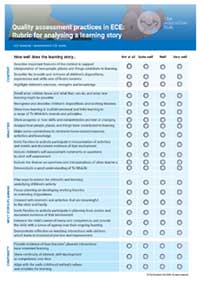In the first three parts of the course, we introduced key principles for extending and enhancing learning in early childhood related to intentional teaching and early childhood assessment practices. We explained:
It is through careful and sensitive assessment that children’s interests and intentions for their own learning can be recognised and supported within a context of supportive intentional interactions that guide and extend children’s learning and development.
In the next part of the course, we begin to look more deeply at how to assess learning in early childhood education using the learning story format, and later in the course we will explore how to use assessments to teach in more intentional ways. A learning story involves careful observation of children’s activity, and then reflection on that observation through processes of describing, recognising and analysing learning, and planning intentional responses. Although our focus in this part is the learning story, these processes will be common to most effective assessment approaches in early childhood education.
In this part of the course, we are aiming to:
This will involve:
Revisit your learning so far
Can you explain what the implications of each of the underpinning principles of Te Whāriki are for assessment practice?:
Read
Read ‘Introduction to Learning Stories’, noting the benefits and issues raised with this form of assessment as you read.
Introduction to Learning Stories
Why use ‘learning stories’?
Assessment in early childhood needs to reflect the complexity of children’s learning and development, and the context of their interactions with people, places and things. Less standardised forms of assessment are often the most appropriate for assessing complex learning in context. Qualitative and interpretive methods that focus on showing the learner and their achievements in the contexts of relationships and environment are better able to capture multiple and less pre-determined outcomes.
Learning stories are narratives created from structured observations, designed to provide a cumulative series of pictures about a child’s learning. They are observations that are reinterpreted as stories, then analysed and used as the basis for planning. Teachers collect ‘critical incidents’ or moments which seem significant for a child. By analysing several of these through narrative, teachers can come to understand the path of the child’s learning and the pattern of their learning dispositions. Several consecutive narratives can be pieced together to make a fuller picture, while remaining open for other pieces to be added.
A series of learning stories is often kept in a portfolio alongside examples of children’s work. This enables teachers to review learning and identify continuity and opportunities for development. Developing stories over time and space (in other words, linking separate stories or adding extra ‘chapters’ to existing stories) enables assessment documentation to show the development of dispositions in different situations, and enables better understanding of the learner in action. When the same sort of learning story appears in different areas of the curriculum, the disposition can be considered more robust.
However, other assessment strategies may also be required in addition to learning stories which do not provide the measurement tools required by the Ministry of Education for identifying specific difficulties or indicating the need for early intervention. Learning stories have also been criticised for a lack of validity, for focusing on one teacher’s observations and analysis rather than drawing on a range of colleagues’ input, for not demonstrating continuity and change in learning over time, for being produced infrequently, and having limited value in different contexts such as school. These are important concerns that can be addressed by embedding effective assessment strategies within the practice of learning stories.
Strengths of a learning story approach
• Encouraging involvement: Stories are generally more engaging and interesting to read than more objective accounts of observations. Using narrative and photographs, which are emotionally appealing and affirming, learning stories can act as a ‘conscription device’ inviting families and children to participate in assessment practices by engaging with the stories, and helping to interpret and plan from them. Learning stories also allow families a window into the practices and purposes of the ECE setting, and draw attention to the kinds of activities which lead to the development of learning dispositions.
• Ability to account for the complexity of learning in early childhood: Learning stories encourage detailed observations and analysis of learners, seeking connections and affirming complexity as an integral part of early childhood learning. By providing rich descriptions, learning stories convey the intensity and complexity of events. They also provide description of the environment and teaching interactions that accompany and support the learning. Stories might say as much about teaching as they do about learning, and therefore they can provide a source of validation for teaching.
• Generative of multiple meanings and interpretations: Learning stories can have various meanings depending on teachers’, children’s, families’ and community values. Learning stories recognise and value the ways in which teachers’ lenses are shaped by their own realities, histories and cultures. By adding other perspectives, including children’s and families’ views, Māori as well as other cultural perspectives, and the values and influences of the wider community, learning stories generate diverse interpretations and ongoing possibilities for sharing, negotiating, revisiting, developing and changing meanings. Such diversity makes space for the uncertainty that should accompany the complexity of learning in early childhood, as development is not standard or linear. Also, the integration of different voices in the assessment process addresses issues of objectivity or validity, so that a more robust analysis of children’s actions can be presented.
• Enabling children’s voices: Learning stories have the potential to develop children’s metacognition, in helping them to think about their knowledge, skills and learning. Inviting children to make their own self-assessments opens spaces for children’s voices and for crucial connections between their everyday realities and the curriculum, which might otherwise go unseen and unknown.
• Constructing competence: ECE assessment in the curriculum document Te Whāriki is underpinned by notions of promoting each child’s growing competence to participate in, and learn about, the world. Learning stories are congruent with this aim in both supporting children’s sense of competence and helping to construct competencies. Learning stories aim to recognise and strengthen children’s learning dispositions, and to create affirming stories that identify children as strong and capable in various roles and contexts. A portfolio collection of learning stories celebrates the child as a competent individual and acknowledges the child’s strengths.
• Enabling continuity: Learning stories can also document interconnections between stories, and aspects of children’s learning, by making links backwards (to previous events) and forwards (to potential plans, the outcomes of which are then documented). This recognises learning as continuous and open to development. Learning stories support ongoing continuity in learning, by identifying connections between and across interests and strengths, and by providing the materials to take learning in new directions.
• Supporting transitions: New Zealand and international research shows that negative impacts of transition to school can be overcome when effective communication channels are established between schools and ECE settings that enable assessment information to be shared and discussed. This sharing and use of assessment information highlights learning and progress over time, and enhances the links between learning that has taken place at an ECE setting and that which occurs at school, and helps children see themselves as competent, confident learners, making transition more likely to be successful. Assessment information empowers children with a strong learner identity as they enter school and, in connecting knowledge of home and the ECE setting with that of school, fosters children’s sense of belonging and engagement.
Read
Read this learning stories exemplar, which consists of three connected learning stories written over two months. The children involved are four and four and a half years old. As you read, look out for evidence of the teachers’ intentional practice and the relationship of assessment to this practice, as your next task involves reflecting on these aspects.
Relate your learning to practice
Rubric for analysing a learning story
Take a completed learning story you have written recently, and complete this interactive table to analyse it.
Check a box for each of the statements to represent your assessment of this story, then print the page or save the file as a PDF from your browser.
Reflect
Look at your findings from the previous activity’s analysis using the rubric above. Which criteria does this story meet well? What are key areas to improve?
Do you think this story would be representative of the quality of most stories for this child / across your early childhood setting? What actions could you put in place to address areas where improvement is needed?
- What are some of the common challenges with learning stories (or other assessment formats you use) in your early childhood setting?
- Which aspects are difficult for you or your team to achieve?
Summary
The key points covered in Part 4 are:
Further reading
This paper helps situate early childhood assessment practice in New Zealand within a range of traditional and contemporary approaches to assessment, and argues that the learning stories have potential to provide assessment that is credible, rich, responsive and morally responsible. Read it online here.
Read our guide to the features of high quality assessment in early childhood. This resource shows how ensuring learning stories are of high quality means attending to issues of content and coverage, analysis, curriculum, learning priorities and links to Te Whāriki, accessibility and collegiality.
Education Review Office. (2007). Quality of assessment in early childhood education. Wellington, NZ: Author.
This report details ERO’s findings regarding quality practices for assessment in ECE, and has been used in the construction of our learning story evaluation rubric. Find this report here.


